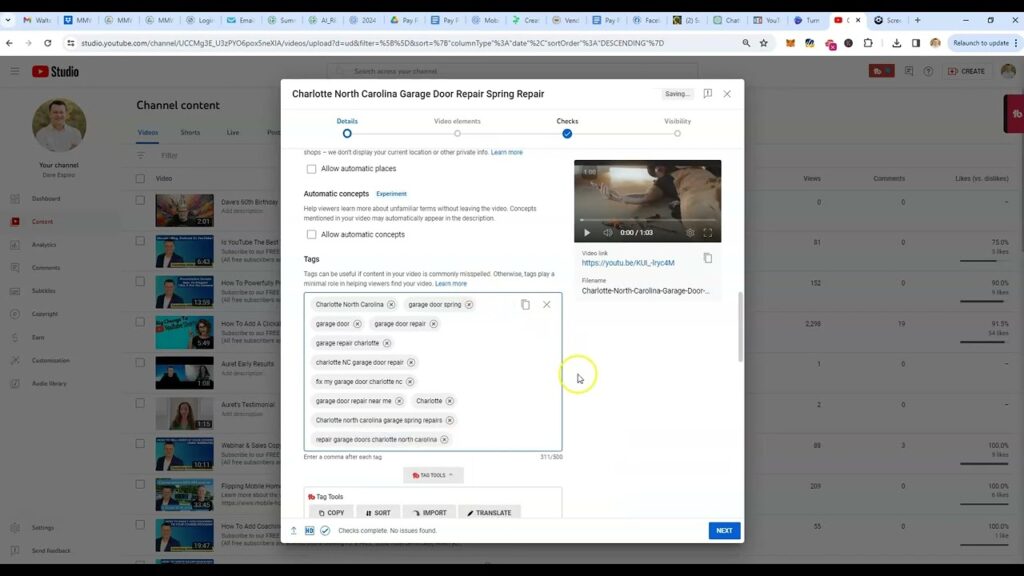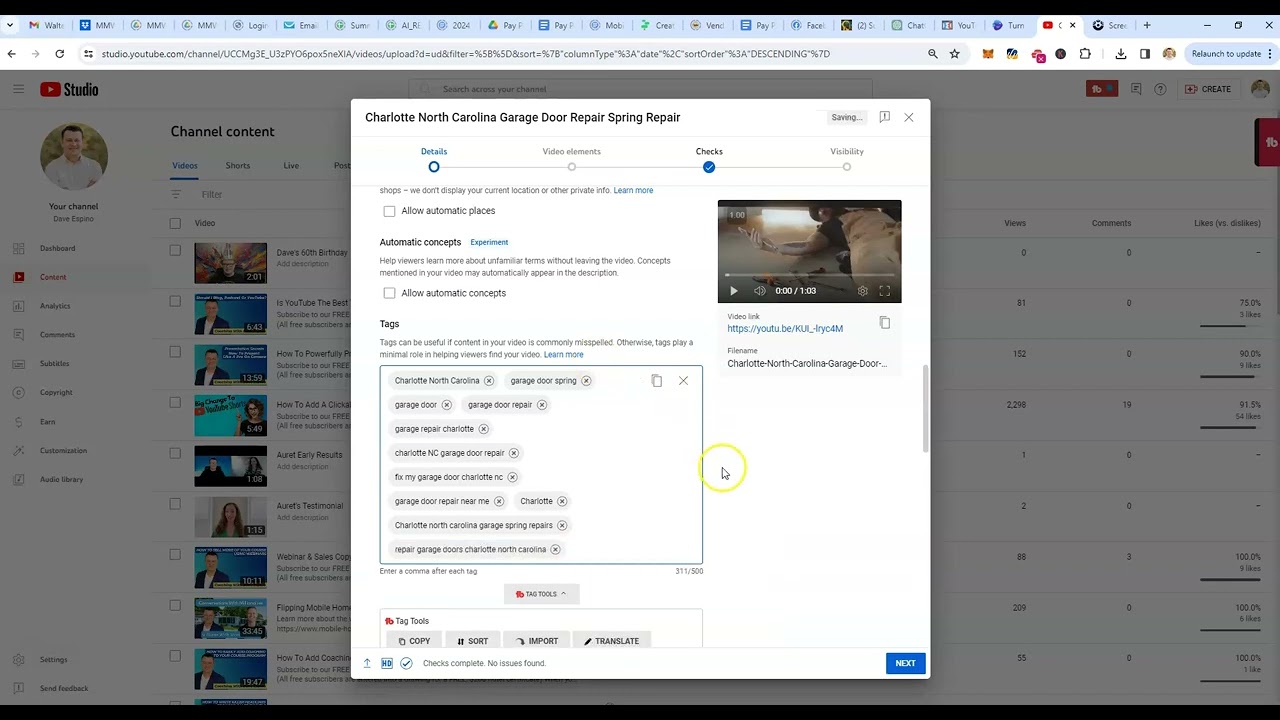In this article, titled “PPC 11” and created by Making Money with AI, we’ll take you through the process of uploading a longer form video on YouTube for an experiment. The article outlines the steps to follow, starting with exporting the video and making some adjustments before uploading it. It also includes valuable tips on SEO optimization, such as using keyword-rich file names and tags to increase the chances of your video ranking on Google and YouTube. By following these steps and implementing effective SEO strategies, you can start generating more views and potentially make money with your videos.
Uploading Long Form Video
To upload a long-form video on YouTube, begin by navigating to your YouTube channel and clicking on the “Past Videos” section. Locate the desired video and click on it. Then, click on “Export” and select the “Export Video” option. This process may take a few moments as the video is rendered.
Once the video is ready, click on “Download” to save the video to your computer. It’s important to note that during the download process, you can customize the file name to be keyword-rich. This will optimize the video for search engine optimization (SEO) purposes. For example, if the video is about garage door repair in Charlotte, North Carolina, you can name the file “Charlotte North Carolina Garage Door Repair.”
After downloading the video, return to your YouTube channel and click on the “Content” tab. From there, select “Create” and choose the option to upload videos. Drag and drop the long-form video file into the designated area.
Next, input the title and description for the video. It’s crucial to include targeted keywords in both the title and description to improve SEO. For example, include keywords like “Charlotte North Carolina” and “garage door repair” in the title and description.
Adding relevant tags is another essential step in content creation. Use tags that are specific to the video’s topic, such as “garage door” and “spring repair.” Additionally, consider including location-specific tags like “Charlotte,” “North Carolina,” or any other relevant terms that users might search for.
Choosing a thumbnail is an important aspect of video uploads. Thumbnails serve as the initial visual representation of your video, so it’s important to select an engaging image that accurately represents the content. In the case of a garage door repair video, consider using a thumbnail that showcases a professional working on a garage door spring.
Lastly, it can be beneficial to add a script to the video description for accessibility and SEO purposes. By including a script, viewers who prefer reading the content or have hearing impairments can still engage with the video. Additionally, search engines like Google and YouTube can extract keywords from the script, further improving the video’s visibility.
SEO Optimization
Optimizing your video for search engine optimization (SEO) is crucial to ensure that it reaches the right audience and appears in relevant search results. Here are some key optimization techniques to consider:
Importance of keyword-rich file name
When saving your video file, give it a keyword-rich name that accurately reflects the video’s content. Include relevant keywords related to the topic, location, and industry. This can help improve the video’s visibility in both Google and YouTube search results.
Targeted tags
Tags play a vital role in SEO optimization. Use tags that are relevant to the video’s content and focus on specific keywords and phrases that users might search for. Incorporate location-specific tags if applicable to increase local visibility.
Optimizing video for Google and YouTube
To optimize your video for Google and YouTube, ensure that the title, description, and tags align with relevant keywords. Incorporate targeted keywords naturally throughout the content while providing valuable information to viewers. This will help search engines understand the video’s content and rank it appropriately.
Thumbnail selection
Selecting an engaging and visually appealing thumbnail is crucial for attracting viewers. Choose a thumbnail that accurately represents the video’s content and entices viewers to click. A high-quality and compelling image can significantly improve click-through rates and overall video performance.

Content Creation
Creating compelling content is essential to captivate and engage viewers. Here are the key steps to follow when creating content for your videos:
Click on content
Access the “Content” tab on your YouTube channel to manage and organize your uploaded videos.
Click on create
Select the “Create” option to initiate the process of uploading a new video.
Upload videos
Drag and drop your desired video file into the designated area to start the upload process.
Input title and description
Provide a descriptive and keyword-rich title for your video. The title should accurately reflect the content and attract viewers’ attention. Then, draft a detailed and engaging description that incorporates targeted keywords naturally. The description should provide an overview of the video and encourage viewers to watch.
Adding tags
Add relevant tags to your video to improve its discoverability in search results. Use keywords and phrases that are closely related to the video’s content and target audience. Incorporate industry-specific terms, location-specific tags, and any other relevant keywords.
Choosing a thumbnail
Select an appealing thumbnail that represents the video’s content effectively. A visually compelling thumbnail increases the chances of attracting viewers and prompting them to click on the video. Choose an image that accurately portrays the video and piques viewers’ curiosity.
Adding script to description
Consider including a transcript or script of the video in the description. This benefits viewers who prefer reading or have hearing impairments. Additionally, search engines can extract keywords from the script, further enhancing SEO.
Additional hashtag usage
To further optimize the video’s visibility, consider adding a few relevant hashtags at the end of the description. Use hashtags that align with the video’s content, industry, and location. Hashtags can help attract a broader audience and improve discoverability.
Video Publishing
Publishing your video involves several important steps to ensure proper visibility and engagement. Here’s a breakdown of the key aspects of video publishing on YouTube:
Language selection
Specify the language your video is in to help YouTube understand the intended audience and improve search visibility.
Embedding
Decide whether you want to allow embedding of your video on external websites. Allowing embedding can increase the video’s reach and potentially attract more viewers from other platforms.
Subscription feed
Choose whether you want to publish the video to your subscribers’ feed. This option informs your subscribers about the new video, increasing the likelihood of engagement and views.
Comment moderation
Specify the level of comment moderation you prefer for your video. Consider setting it to “Strict” to maintain a positive and engaging comment section.
Displaying viewers and likes
Choose whether you want YouTube to display the number of viewers and likes publicly. This feature can add social proof and credibility to your video, attracting more viewers.
Publishing video
Once all the settings are configured, click on “Publish” to make your video public on YouTube. A unique URL will be created for your video, which you can share with others.
Importance of SEO
Implementing effective SEO strategies is crucial for maximizing the visibility, reach, and engagement of your videos. Here are the key elements to consider when optimizing your videos for search engines:
Optimizing title for targeted keywords
Craft a compelling and keyword-rich title that accurately reflects the video’s content. Include targeted keywords that users might search for to improve the video’s ranking in search results. The title should be concise, engaging, and optimized for relevant keywords.
Optimizing first line of description
The first line of your video description should contain important keywords that summarize the video’s content. This snippet appears prominently in search results, so make it concise and attention-grabbing to entice viewers to click.
Incorporating keywords into script
When creating your video’s script, incorporate relevant keywords naturally. By mentioning targeted keywords throughout the video, you provide search engines with more context about its content, improving its visibility and ranking potential.
Keyword-rich file name
Optimize your video’s file name by including targeted keywords related to its content. A keyword-rich file name can significantly impact its visibility in both Google and YouTube search results.
Hashtag usage
Incorporating relevant hashtags at the end of your video description can improve its discoverability within YouTube’s search algorithm. Use keywords, industry-specific terms, and location-specific tags as hashtags to attract a wider audience.
YouTube algorithm understanding
Familiarize yourself with how YouTube’s algorithm ranks and recommends videos. Stay informed about any algorithm updates and trends to ensure your content aligns with YouTube’s requirements and viewer preferences.
Conclusion
Uploading long-form videos on YouTube requires careful attention to detail and strategic optimization techniques. By following the outlined steps, you can enhance the discoverability, visibility, and engagement of your videos. Implement effective SEO strategies, create compelling content, and utilize features like targeted tags, keyword-rich file names, and accurate thumbnails to attract viewers and maximize the potential of your YouTube channel. Remember to stay up-to-date with SEO best practices and algorithm updates to ensure your videos continue to perform well in search results.
